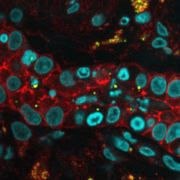A new study on the dynamics of Hepatitis C virus entry published in Hepatology (IF=17.4)
The study conducted by Maika Deffieu and Raphael Gaudin highlights the complex interactions between the hepatitis C virus (HCV) and its receptors, and in particular with occludin.
Thanks to the use of the CRISPR technology, the team was able to introduce the fluorescent protein EGFP into the genome of hepatic cells in order to follow the localization of endogenous occludin in real time. Thus,it has been demonstrated in cell lines and in human liver explants that HCV particles do not slide towards tight junctions, as opposed to the previously assumed dogma. On the contrary, the virus has acquired the ability to accumulate occludin on the surface of target cells, outside the tight junctions. The recruitment of occludin to the viral particle allows stabilization, then internalization of the virus.
This work redefines the spatiotemporal dynamics of HCV entry in relevant models and provides new information on the molecular mechanisms manipulated by the virus to promote its dissemination.








